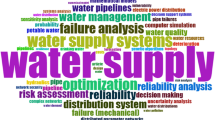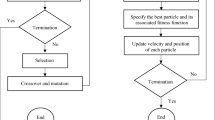Abstract
Among the most important components of sustainable management strategies for water distribution networks is the ability to integrate risk analysis and asset management decision-support systems (DSS), as well as the ability to incorporate in the analysis financial and socio-political parameters that are associated with the networks in study. Presented herein is a neurofuzzy decision-support system for the performance of multi-factored risk-of-failure analysis and pipe asset management, as applied to urban water distribution networks. The study is based on two datasets (one from New York City and the other from the city of Limassol, Cyprus), analytical and numerical methods, and artificial intelligence techniques (artificial neural networks and fuzzy logic) that capture the underlying knowledge and transform the patterns of the network’s behaviour into a knowledge-repository and a DSS.
Similar content being viewed by others
Explore related subjects
Discover the latest articles and news from researchers in related subjects, suggested using machine learning.References
Andreou SA, Marks DH, Clark RM (1987) New methodology for modelling break failure patterns in deteriorating water distribution systems: applications. Adv Water Resour AWREDI 10:2–10
Aslani P (2003) Hazard rate modeling and risk analysis of water mains. MSc thesis, Polytechnic University
Charalambous B (2005) Experiences in DMA redesign at the water board of Lemesos, Cyprus. In: International water association’s specialised conference on leakage. Halifax, Nova Scotia, Canada, pp 403–413
Christodoulou S, Aslani P, Vanrenterghem A (2003) A risk analysis framework for evaluating structural degradation of water mains in urban settings, using neurofuzzy systems and statistical modeling techniques. In: World water & environmental resources congress 2003 and related symposia, Pennsylvania, USA
Christodoulou S, Charalambous B, Adamou A (2007) Managing the ‘repair or replace’ dilemma on water leakages. In: International water association’s (IWA) third specialty conference on water loss reduction (Water loss 2007), Bucharest, Romania
Clark RM, Stafford CL, Goodrich JA (1982) Water distribution systems: a spatial and cost evaluation. J Water Resour Plan Manage Div 108:243–256
Ekinci O, Konak H (2009) An optimization strategy for water distribution networks. Water Resour Manag 23:169–185
El-Shafie A, Taha MR, Noureldin A (2007) A neuro-fuzzy model for inflow forecasting of the Nile river at Aswan high dam. Water Resour Manag 21:533–556
Goulter IC, Kazemi A (1988) Spatial and temporal groupings of water main pipe breakage in Winnipeg. Can J Civil Eng 15:91–97
Hajkowicz S, Collins K (2007) A review of multiple criteria analysis for water resources planning and management. Water Resour Manag 21:1553–1566
Kleiner Y, Rajani B (1999) Using limited data to assess future needs. J Am Water Works Assoc 91:47–61
Lu HW, Huang G, Zeng GM, Maqsood I, He L (2008) An inexact two-stage fuzzy-stochastic programming model for water resources management. Water Resour Manag 22:991–1016
Park S, Kim BJ, Im GC (2008) Modeling of water main failure rates using the log-linear ROCOF and the power law process. Water Resour Manag 22:1311–1324
Shamir U, Howard C (1979) An analytical approach to scheduling pipe replacement. J Am Water Works Assoc 71:248–258
Tabesh M, Yekta AH, Burrows R (2009) An integrated model to evaluate losses in water distribution systems. Water Resour Manag 23:477–492
Vanrenterghem-Raven A, Eisenbeis P, Juran I, Christodoulou S (2004) Statistical modeling of the structural degradation of an urban water distribution system: case study of New York City. In: World water & environmental resources congress 2003 and related symposia, Pennsylvania, USA
Zadeh L (1965) Fuzzy sets. Inf Control 8:338–353
Author information
Authors and Affiliations
Corresponding author
Rights and permissions
About this article
Cite this article
Christodoulou, S., Deligianni, A. A Neurofuzzy Decision Framework for the Management of Water Distribution Networks. Water Resour Manage 24, 139–156 (2010). https://doi.org/10.1007/s11269-009-9441-2
Received:
Accepted:
Published:
Issue Date:
DOI: https://doi.org/10.1007/s11269-009-9441-2




